
Billardiera cymosa, commonly known as sweet apple-berry or love fruit, is a species of flowering plant in the family Pittosporaceae and is endemic to south-eastern continental Australia. It is usually a slender climber that has narrowly egg-shaped leaves and pale blue or pale purplish flowers arranged in groups of about five to twelve.
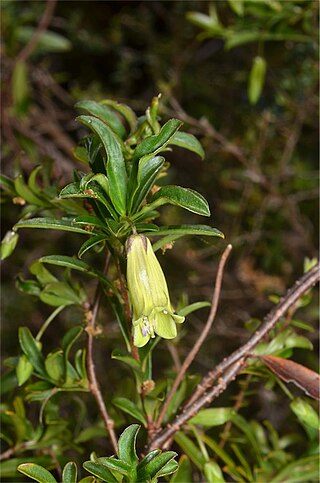
Billardiera longiflora is a species of flowering plant in the family Pittosporaceae and is endemic to Tasmania. It is a woody twiner or climber that has variably-shaped, often elliptic leaves, often varying with altitude, and greenish-yellow, pendent, tube-shaped flowers arranged singly and turning blue as they age. This species is often confused with the similar Billardiera macrantha of south-eastern Australia, including Tasmania.
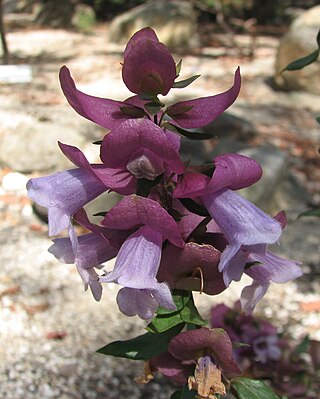
Prostanthera magnifica, commonly known as magnificent prostanthera, is a species of flowering plant in the family Lamiaceae and is endemic to Western Australia. It is a slender to spreading, erect shrub that has hairy stems, elliptical to narrow egg-shaped leaves and pale mauve or pale blue to pink flowers with prominent dark mauve to purple sepals.
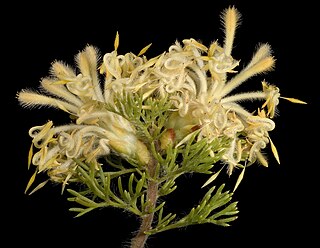
Petrophile serruriae is a species of flowering plant in the family Proteaceae and is endemic to southwestern Western Australia. It is a shrub with crowded, pinnate, needle-shaped, sharply-pointed leaves, and oval heads of silky-hairy yellow, greyish mauve to pink flowers.

Billardiera fraseri, commonly known as elegant pronaya, is a species of flowering plant in the family Pittosporaceae and is endemic to the south-west of Western Australia. It is a climber with densely silky-hairy new shoots, leaves and flowers, narrowly elliptic leaves and deep purple or pink flowers arranged in groups.

Billardiera fusiformis, commonly known as Australian bluebell, is a species of flowering plant in the family Pittosporaceae and is endemic to the south-west of Western Australia. It is a sturdy, shrubby climber that has linear to narrowly elliptic leaves and blue, white or pink, nodding flowers arranged singly or in groups of up to four.

Billardiera coriacea is a species of flowering plant in the family Pittosporaceae and is endemic to the south-west of Western Australia. It is a woody scrambler or climber that has more or less oblong leaves, the flowers white to pale yellow and arranged singly or in small groups on short side shoots.

Marianthus tenuis is a species of flowering plant in the family Pittosporaceae and is endemic to the southwest of Western Australia. It is a slender, twining shrub with clustered, narrowly elliptic leaves and white flowers tinged with mauve and with darker spots on three of the five petals.

Lasiopetalum drummondii is a species of flowering plant in the family Malvaceae and is endemic to the south-west of Western Australia. It is an erect, slender shrub with many densely hairy stems, egg-shaped or oblong leaves and white, pink and red flowers.
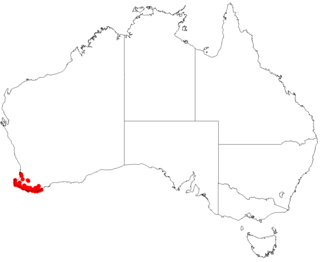
Billardiera laxiflora is a species of flowering plant in the family Pittosporaceae and is endemic to the far south-west of Western Australia. It is a delicate, twining shrub or climber that has linear leaves and white flowers tinged or spotted with pink or mauve.

Billardiera lehmanniana, commonly known as kurup, is a species of flowering plant in the family Pittosporaceae and is endemic to Western Australia. It is a glabrous shrub or climber that has linear to oblong leaves with the edges curved upwards and large groups of flowers with widely spreading pale mauve petals that darken as they age.

Billardiera mutabilis, commonly known as climbing apple berry, apple berry, snot berry, apple dumplings or changeable-flowered billardiera, is a species of flowering plant in the family Pittosporaceae and is endemic to south-eastern Australia. It is a slender climber or twiner with narrowly elliptic leaves and bell-shaped, greenish-yellow flowers that turn bluish as they age.

Marianthus bignoniaceus, commonly known as orange bell-creeper, is a species of flowering plant in the family Pittosporaceae and is endemic to Victoria. It is a slender climber with egg-shaped or narrowly egg-shaped leaves and green and orange or salmon-pink flowers arranged singly or in pairs.

Billardiera nesophila is a species of flowering plant in the family Pittosporaceae and is endemic to Tasmania. It is a slender, twining shrub that has narrowly elliptic leaves and pendent yellowish-green flowers that turn canary yellow as they age.

Billardiera rubens is a species of flowering plant in the family Pittosporaceae and is endemic to eastern Australia. It is a vigorous climber that has narrowly egg-shaped leaves and pendent yellow flowers with a reddish tinge on the edges.

Billardiera speciosa is a species of flowering plant in the family Pittosporaceae and is endemic to southern Western Australia. It is a slender climber that grows in coastal heath and has narrowly elliptic leaves with the edges rolled under and groups of purple or mauve flowers.

Billardiera variifolia is a species of flowering plant in the family Pittosporaceae and is endemic to the southwest of Western Australia. It is a twining shrub or climber with elliptic adult leaves and groups of deep purple flowers that fade to blue as they age.
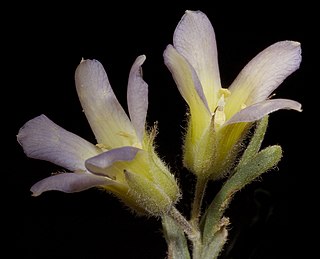
Billardiera venusta is a species of flowering plant in the family Pittosporaceae and is endemic to the southwest of Western Australia. It is a woody climber or shrub with clustered sessile, hooked leaves and groups of four to six pale lilac flowers that fade to yellow as they age.
Marianthus sylvaticus is a species of flowering plant in the family Pittosporaceae and is endemic to a small area in the southwest of Western Australia. It is a slender climber with clustered, toothed, linear leaves and blue and white flowers with purple veins.

Billardiera viridiflora is a species of flowering plant in the family Pittosporaceae and is endemic to a small area in the north-west of Tasmania. It is a twining shrub that has narrowly elliptic leaves and pendent greenish yellow flowers that turn a deeper yellow as they age.




















